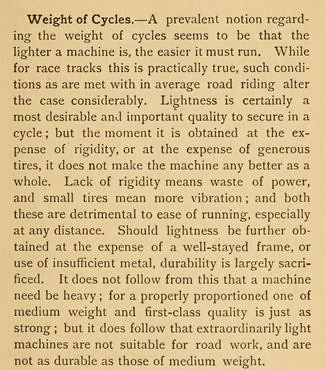
A discussion of the all-important bicycle weight question
A prevalent notion regarding the weight of cycles seems to be that the lighter a machine is, the easier it must run. While for race tracks this is practically true, such conditions as are met with in average road riding alter the case considerably. Lightness is certainly a most desirable and important quality to secure in a cycle; but the moment it is obtained at the expense of rigidity, or at the expense of generous tires, it does not make the machine any better as a whole. Lack of rigidity means waste of power, and small tires mean more vibration; and both these are detrimental to ease of running, especially at any distance. Should lightness be further obtained at the expense of a well-stayed frame, or use of insufficient metal, durability is largely sacrificed. It does not follow from this that a machine need be heavy; for a properly proportioned one of medium weight and first-class quality is just as strong; but it does follow that extraordinarily light machines are not suitable for road work, and are not as durable as those of medium weight.A reasonable point of view! The author goes on to offer further analysis~
Since 1892 the advance that has been made in building light bicycles has been absolutely extraordinary, and in less than three years the weight of road machines has been reduced from forty-five to twenty-two or twenty-three pounds. No man, however heavy, need ride a modern wheel of over thirty pounds' weight; very few need ride over twenty-five pound wheels, while the majority of good riders can be safely fitted with wheels that weigh but twenty-two or twenty-three pounds. Of course a good many wheels at even less weight than this will be used on the road, but it should be done with extreme caution. Track racers run from fifteen to eighteen pounds.A modern carbon fiber racing bike that weighed around fifteen pounds would be a costly item, but the track bike described for the 1890s would not have any gears or brakes, which do add weight even on a modern bike. And to save weight, the wheels of an 1890s track bike might well have been made of wood.
Still, one wonders at how quickly steel cycle builders of the 19th century managed to make lightweight track cycles that rival those of a hundred years later in certain measures.

Typical single speed cycle from 1897
No comments:
Post a Comment